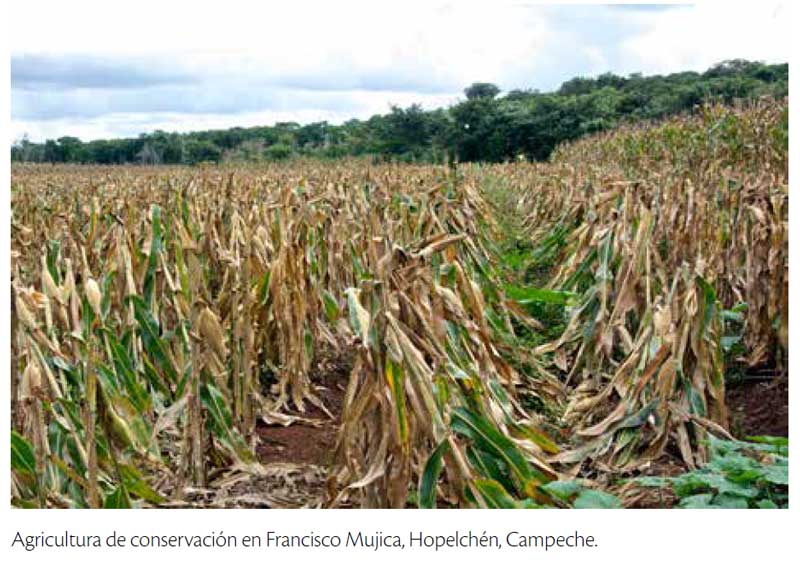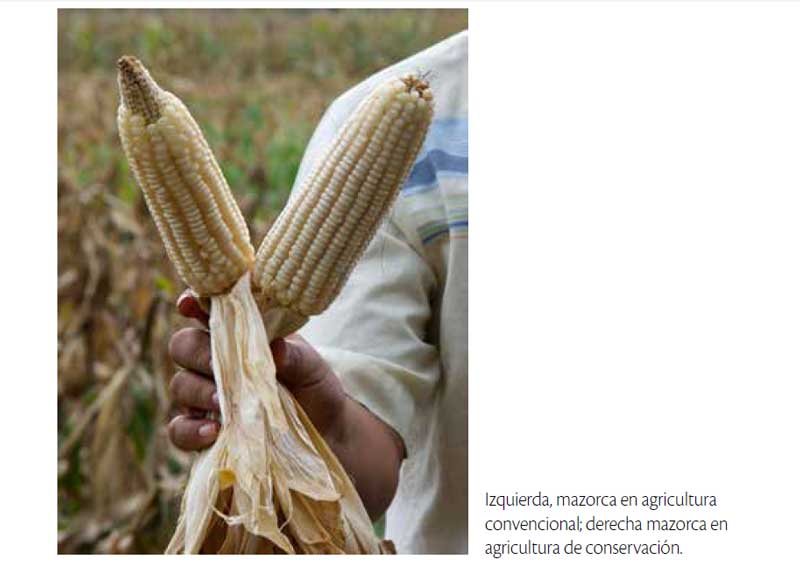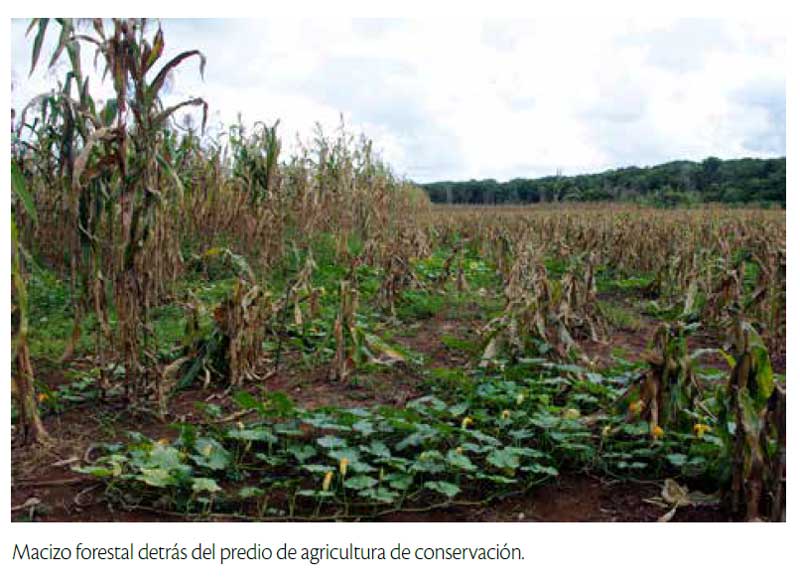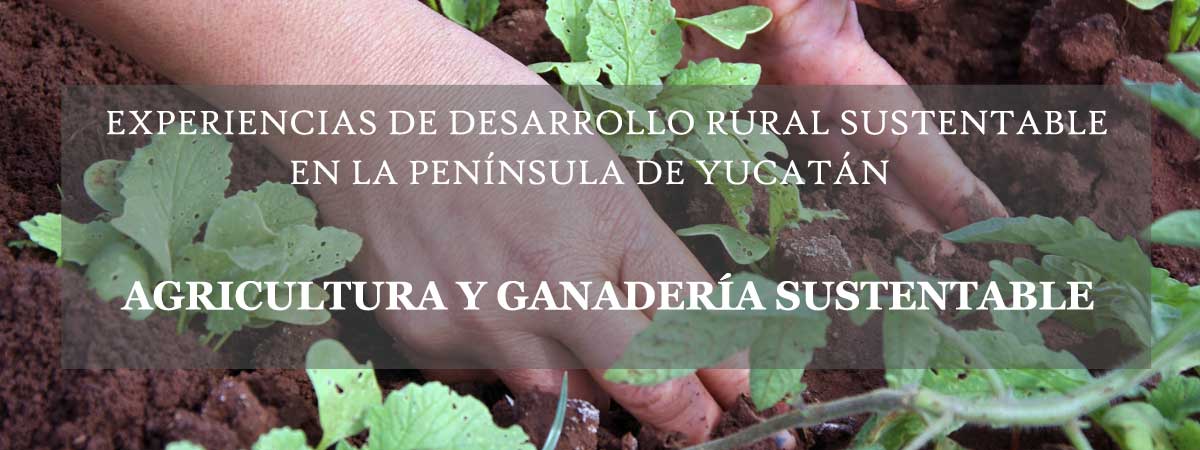Conservation agriculture and silvopastoral systems
 Introduction The region known as Los Chenes, in the state of Campeche, is recognized for its high biological value. However, some 30 years ago, the advance of the agricultural frontier has gradually been reducing its natural capital. Because of these factors, along with the Puuc area in Yucatan, this region was designated as a strategic area for the REDD+ initiative. A portion of the agricultural production is under the model of traditional subsistence, but a greater percentage is represented by mechanized agriculture. In this context, Pronatura Península de Yucatán is testing a technique of conservation agriculture with three basic principles: minimum soil movement, soil surface cover of crop residues and crop rotation; which in turn is based on a strategy model developed by the MasAgro program of the International Maize and Wheat Improvement Center (CIMMYT). This project seeks to maintain soil fertility, reduce the use of fossil fuels and increase yields per hectare. Therefore, the goal is to maintain the level of production in areas designated for agriculture and avoid the conversion of new forest areas into crop fields. |
 Initial situation In a territorial analysis assisted by satellite images, a heterogeneous tapestry of forests interspersed with small and large deforested plots can be seen. Visiting the territory allows one to notice that the landscape is dominated by the meeting of two contemporary cultures: traditional Mayan and Mennonite villages. The project's objective is to achieve a change in farming practices of both populations; although the methodological tools to be used require a different approach, depending on whether one is working with a Mennonite or Mayan traditional village. The last and most ambitious goal, worth the effort, is to reconcile the conservation of the natural heritage of this region with the welfare of their inhabitants. |
"The first steps were difficult because the project did not render interest among the potential participants", recalls Carlos Cecilio Zi Dzib, then Pronatura field manager of sustainable agriculture. He recalls the first introductory workshop on conservation agriculture, for which they invited forty people in the community and only five attended. Soon after, people began to come closer because they were interested in learning about the proposal. "It's logical," said Carlos Cecilio, "for generations people have been plowing the land and applying agrochemicals. For example, if they have an attack of the fall armyworm in maize, they think: how can I not apply insecticide? What is harder for them to see is that crop rotation breaks the pest cycle and reduces pesticide use". |
| The proposal aims to demonstrate that with the slightest movement of the topsoil, the physical and chemical properties of the soil profile, as well as their water storage capacity, are conserved. Leaving the stubble (crop residue) on the ground helps maintain soil moisture, while incorporating organic matter. Finally, crop rotation not only breaks the natural cycle of the pests but also brings new nutrients into the soil; for example, if after corn we have a bean cycle we will be providing nitrogen for the next crop. |
| Key moments It has been key for the project to "learn by doing", and with the support from the Mexico AMREDD+ Alliance they began working with five producers from the community, who were invited to establish modules of sustainable practices. "For example, says the field expert, now is the time to leave the stubble; so we bring people to the field to give a talk about the importance of this practice, and the farmers can check by themselves how humidity is maintained below that stubble. Through these conservation practices we can achieve higher productivity compared to conventional agriculture". When first visiting the plots they were still a few days away from harvesting and then measuring crop yields. Nonetheless, the field expert randomly got two cobs, one from the land with conservation agriculture and the other from a control plot under conventional agriculture. The result was in view of everyone there: maize produced with conservation agriculture had a more complete cob. This is even more relevant when one considers that under conservation agriculture tractor use decreased by 50%, as did the equivalent of fuel consumption. |
| Less than a year into the project, a key moment was when the producers saw the benefits of the conservation agriculture system after two months of drought. Producers who did not carry out such practices got smaller cobs, and those that made conservation practices achieved more developed ones. "And still producers have to see the result of leaving the stubble on the soil and rotating crops", says Carlos with optimism. Alongside conservation agriculture, Pronatura Península de Yucatán has been piloting improved practices for livestock production through silvopastoral systems. These systems imply the improvement of pastures by combining them with high protein shrubs such as Leucaena leucocephala cv. cunningham, and establishing additional tree species in the periphery such as cedar, mahogany, guava and nance, available to be used for livestock and humans.  |
| Lessons learned "The best way to induce change is by showing it, not only with theoretical explanations," says the Carlos Cecilio. Five producers began in this project, and within a year from starting they got thirty more people in the community of Francisco Mujica, plus another twenty from Ramon Corona who wanted to become involved. "At this early stage we aim to change ways of thinking, of producing, of doing things; and the next stage is to improve yields and have surplus for the market". Less than a year from starting, the field expert believes they have already partially succeeded in stopping deforestation. "That strip of forest, says pointing out to a forested area, was in the plans of being felled by a producer. But when seeing the good yields of his crops this year, it remained untouched, and we expect that behavior to be maintained over time. We have seen a change in the community, there is now more movement, they clean their streets, they no longer fell the forest and have more courage to work the fields". |
||
| MasAgro strategy. SAGARPA-CIMMYT | ||
| MasAgro is a strategy developed by CIMMYT, and its objective is to enable farmers to achieve higher and more stable yields, increase their income and contribute to mitigate the effects of climate change. For the implementation of the strategy the program was designed in innovation nodes, also called “hubs”. The most recent of these innovation nodes is denominated Yucatan Hub, beginning activities in the year 2014. During the first year the approach of this hub has been to create capacities in technical advisers about conservation agriculture, such as no-till, stubble management and crop rotation. By the year 2015, the Yucatan Hub plans to implement its strategy consolidating a scheme as an experimental platform, modules of sustainable practices and extension areas. The experimental platforms are extensions that will generate technologies, as well as to investigate and develop capacities. The modules of sustainable practices will serve as promotion amongst leading farmers in order to apply the knowledge in the areas of technology extension. The experience of Pronatura, strategic partner of MasAgro in the region, will be considered as a module of sustainable practices. |
||



















